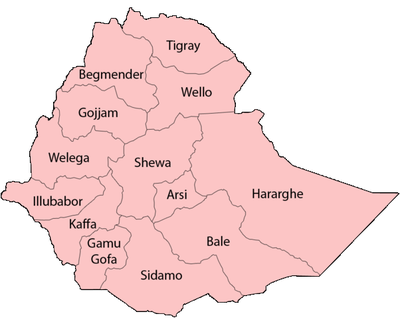Kaffa Province

Kaffa (Kefa) was a province on the southwestern side of Ethiopia; its capital city was Jimma. It was named after the former Kingdom of Kaffa. The etymology of Kaffa is apparently from Arabic qahwah ‘a drink from berries’.[1] For further see the entry Coffee.
Kaffa was bordered on the west by Sudan, on the northwest by Illubabor, on the north by Walega, on the northeast by Shewa, on the east by Sidamo, and on the southeast by Gamu-Gofa.
History
This province came into existence as a result of Proclamation 1943/1, which created 12 taklai ghizats from the existing 42 provinces of varying sizes.[2] A comparison of the two maps in Margary Perham, The Government of Ethiopia shows that Kaffa was created by combining the former kingdoms of Kaffa, Jimma, Gera, Gomma, Limmu and Janjero, with the 1935 provinces of Guraferda, Benesso, Maji, Shewa Gimira, Goldiya, Konta, Kullo.[3] As a result, the Kingdom of Kaffa, which had been conquered by Menelik II of Ethiopia in 1897, contributed the name to the new province, while the Kingdom of Jimma, an old rival to Kaffa, contributed the capital city.
With the adoption of the new constitution in 1995, Kaffa became part of the Oromia and Southern Nations, Nationalities, and Peoples Regions.
Economy and Environment
Southern Ethiopia, including Sidamo, Kaffa, Arsi and Harar is the original home of coffee [4] which grows wild here in the mountain rain forests in countless varieties. All plants of the species Coffea arabica around the world are descendants of plants from southern Ethiopia.[5]
Coffee has long been the main source of income, but due to the sharply declining world prices for coffee, the residents increasingly have to grow other crops. By turning rain forests into new agricultural land, the structure of the region is heavily damaged.
The rain forests that dominated the region of Kaffa earlier are reduced to only 3% of their original size, in the last 30 years 60% of the trees were lost.
For some years there is a large rain forest conservation project, which relies on the use of the last wild stocks of coffee growing in the rain forest. Currently, some 30 cooperatives are harvesting and marketing this specialty coffee and have helped over 40,000 people to get income.
In 2010, an area within the Kaffa province was recognised as a UNESCO Biosphere Reserve as part of the Man and the Biosphere Programme. Officially named the "Kafa Biosphere Reserve" it is one of the first two biosphere reserves in Ethiopia and aims to protect the natural environment and foster sustainable development in the region.[6] Lions were photographed in the reserve in 2012, the first documenting of that species in montane rainforest.[7]
Notes
- ↑ Wilhelm Sturmfels and Heinz Bischof: Unsere Ortsnamen im ABC erklärt nach Herkunft und Bedeutung, Bonn, 1961, Ferdinand Dümmlers Verlag
- ↑ Bereket Habte Selassie, "Constitutional Development in Ethiopia", Journal of African Law, 10 (1966), p. 79.
- ↑ Perham, The Government of Ethiopia, second edition (London: Faber and Faber, 1969), maps 1 and 2
- ↑ Halevy Alon, Halevy Oriana (2011) "The Infinite Emotions of Coffee" pp. 32 "the Arabica coffee tree originated from Southwestern Ethiopia".
- ↑ Halevy Alon, Halevy Oriana (2011) "The Infinite Emotions of Coffee" pp. 32 "the Arabica coffee tree originated from Southwestern Ethiopia".
- ↑ Kafa Biosphere Reserve, retrieved 16 October 2012
- ↑ Africa lions documented in montane rain forest for the very first time
Coordinates: 7°N 37°E / 7°N 37°E